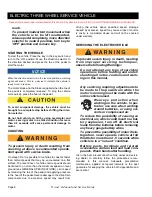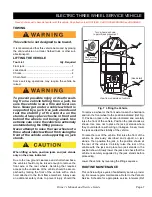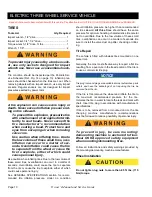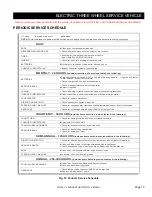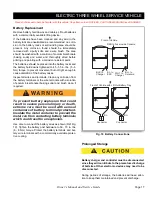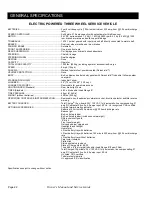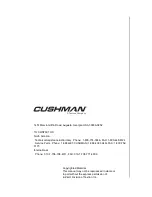
ELECTRIC THREE WHEEL SERVICE VEHICLE
Page 19
Owner’s Manual and Service Guide
Read all of manual to become familiar with this vehicle. Pay attention to all NOTICES, CAUTIONS,WARNINGS and DANGERS.
TROUBLESHOOTING
In general, troubleshooting will be done for two distinct
reasons. First, a battery that performs poorly and is out-
side of the manufacturers specification should be identi-
fied in order to replace it under the terms of the
manufacturer’s warranty. Different manufacturers have
different requirements. Consult the battery manufacturer
or a service representative for specific requirements.
The second reason is to determine why a particular vehi-
cle does not perform adequately. Performance problems
may result in a vehicle that runs slowly or in a vehicle that
is unable to operate for the time required.
A new battery must
mature
before it will develop its max-
imum capacity. Maturing may take up to 100 charge/dis-
charge cycles. After the maturing phase, the older a
battery gets, the lower the capacity. The only way to
determine the capacity of a battery is to perform a load
test using a discharge machine following manufacturer’s
recommendations.
A cost effective way to identify a poorly performing bat-
tery is to use a hydrometer to identify a battery in a set
with a lower than normal specific gravity. Once the partic-
ular cell or cells that are the problem are identified, the
suspect battery can be removed and replaced. At this
point there is nothing that can be done to salvage the
battery; however, the individual battery should be
replaced with a good battery of the same brand, type and
approximate age.
Hydrometer
A hydrometer (P/N 50900-G1) is used to test the state of
charge of a battery cell (Ref Fig. 21). This is performed
by measuring the density of the electrolyte, which is
accomplished by measuring the specific gravity of the
electrolyte. The greater the concentration of sulfuric acid,
the more dense the electrolyte becomes. The higher the
density, the higher the state of charge.
To prevent battery explosion that could
result in severe personal injury or death,
never insert a metal thermometer into a bat-
tery. Use a hydrometer with a built in ther-
m o m e t e r t h a t i s d e s i g n e d f o r t e s t i n g
batteries.
Specific gravity is the measurement of a liquid that is
compared to a baseline. The baseline is water which is
assigned a base number of 1.000. The concentration of
sulfuric acid to water in a new golf car battery is 1.280
which means that the electrolyte weighs 1.280 times the
weight of the same volume of water. A fully charged bat-
tery will test at 1.275 - 1.280 while a discharged battery
will read in the 1.140 range.
Do not perform a hydrometer test on a battery that has just
been watered. The battery must go through at least one charge
and discharge cycle in order to permit the water to adequately
mix with the electrolyte.
The temperature of the
electrolyte
is important since the
hydrometer reading must be corrected to 80° F (27° C).
High quality hydrometers are equipped with an internal
thermometer that will measure the temperature of the
electrolyte and will include a conversion scale to correct
the float reading. It is important to recognize that the
electrolyte temperature is significantly different from the
ambient temperature if the vehicle has been operated.
Fig. 21 Hydrometer
32
28
24
20
16
12
8
4
0
4
8
12
16
20
24
28
32
36
32
28
24
20
16
12
8
4
0
4
4
8
12
12
16
16
20
20
24
24
28
28
32
32
36
36
1100
1125
1150
1200
1225
1250
1275
1300
1100
1125
1150
1200
1225
1250
1275
1300
Add to Float
Reading
Subtract
from Float
Reading
Bulb
Cylinder
Float
Weight
Thermometer
1175
NOTICE


